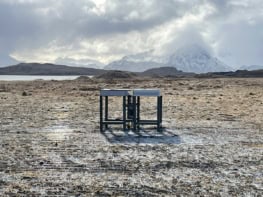
The impact of a spacecraft into the asteroid Dimorphos last year changed the asteroid’s orbital period around its companion asteroid, Didymos, by 33 minutes, with much of the momentum change coming from the ejecta liberated by the impact. That is one of the findings from a quintet of new papers that has now verified the amount by which the impact knocked the 177 m-wide Dimorphos from its orbit.
The Double Asteroid Redirection Test (DART) was a NASA spacecraft designed as a test of whether it is possible in future to deflect a potentially hazardous asteroid away from Earth.
DART struck Dimorphos on 26 September 2022, obliterating the spacecraft and excavating a crater on the surface that led to streams of ejecta stretching away from the wounded asteroid, which were captured by the Hubble and James Webb space telescopes.
The successful impact resulted in NASA and a team led by the Johns Hopkins Applied Physics Laboratory in the US bagging the Physics World 2022 Breakthrough of the Year award.
NASA had expected that Dimorphos’ orbit would undergo a minimum change by about seven minutes after impact. Yet observations of the double asteroid’s light curve that tracks how the two asteroids orbit around each other, periodically eclipsing one another, as well as radar measurements, indicate that Dimorphos’ orbital period around the larger 850 m-wide Didymos was slowed by 33 minutes.
“A lot of people had this assumption that we were taking two billiard balls and jut crashing one into the other,” says Cristina Thomas of Northern Arizona University, lead author of one of the new papers.
Instead, DART was crashing into little more than a loosely consolidated rubble pile and was able to kick out plenty of material into space.
“That material has its own momentum,” Thomas told Physics World. “We refer to that as ‘momentum enhancement’ because it’s above and beyond what we would expect from an inelastic collision.” DART mission successfully hits asteroid in first-of-its-kind test
It was this momentum enhancement that made up the difference between seven and 33 minutes in the change in orbital period. This suggests that most of the momentum change imparted on Dimorphos came not directly from DART’s kinetic impact, but from the ejecta causing a recoil on the asteroid.
The finding has consequences for when it may be necessary to deflect a hazardous asteroid away from Earth. The extra push from the ejecta means that it could be possible to deflect an asteroid with less time before impact than originally thought. “[It] really changes the way that we think about the scale of asteroid deflection,” says Thomas.
Thomas points out, however, that DART’s impact “is just one data point” and other asteroids could have different properties. “But as we do think that a lot of asteroids are rubble piles, it gives us a little bit of room when it comes to deflecting them,” adds Thomas.
Other findings
Another paper expands on the momentum enhancement. By Andy Cheng of the Johns Hopkins University Applied Physics Laboratory and colleagues, it finds that the impact itself resulted in an instantaneous reduction in Dimorphos’ orbital velocity of 2.7 mm per second – high enough to implicate recoil from the release of ejecta.
In a third paper, led by Ariel Graykowski of the SETI Institute, and utilising the observations of citizen scientists, the amount of brightening of Dimorphos in the aftermath of the collision led to an estimate of the mass of the ejecta being 0.3–0.5 per cent of Dimorphos’ total mass. Deflection of a near-Earth asteroid by DART is the Physics World 2022 Breakthrough of the Year
The ejecta streams evolved complexly, as first gravity from the two asteroids, and then radiation pressure from the solar wind, acted on them, according to a fourth paper led by Jian-Yang Li of the Planetary Science Institute in Arizona.
Li led Hubble Space Telescope observations of the impact, which showed a cone of ejecta being twisted by the asteroids’ gravity, before the photon pressure of sunlight pushed the ejecta away in two dust tails. A fifth paper summarises the results for what was a successful test of kinetic impactor technology for planetary defence.
The European Space Agency’s Hera mission, which launched in October 2024, is expected to arrive at the Didymos–Dimorphos system in 2026. Hera will follow up on the aftermath of the impact, image the resulting crater and characterise the two asteroids overall.
The five papers are published in Nature.



